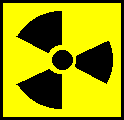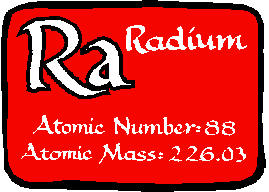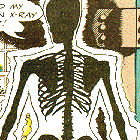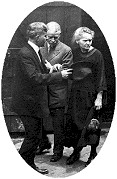|
Name/Origin: Radium comes
from the Latin word “radius” which means ray. It is called ray because it is
a radioactive metal that emits alpha, beta,
and gamma rays as it decays.It doesn’t have an extensive history because it is a recently isolated and discovered element. It was
discovered only in the early 1900’s.
|
 |
|
Symbol: Ra |
|
|
Classification: alkaline
earth metal |
|
|
|
|
Physical
Properties
|
|
|
Description:
lustrous radioactive metal-Radium is a
white lustrous metal that has cubic crystal
structure,
and relatively high melting and boiling point.
|
|
Crystal Structure:
Cubic |
|
|
Color: silver/white
(lustrous) |
|
|
Taste: unknown |
|
|
Texture: unknown |
|
|
Intensive properties:
Density @ 293 K:
5.0 g/cm3
Boiling Point:
1737.0 °C (2010.15 °K, 3158.6 °F)
Melting Point:
700.0 °C (973.15 °K, 1292.0 °F) |
 |
|
|
|
|
Chemical Properties: |
|
|
Properties:
*Radium is intensely
radioactive, and as it spontaneously decays, it releases
energy in the form
of alpha, beta, and gamma rays. As the nucleus of radium decays, radium
atoms transform into atoms of new and different elements. The final product
of radium decay is the
element lead. In
addition, radium’s
gamma rays kill
organisms. Gamma rays are the most
dangerous because they have greatest penetrating
power and will
ionize the atoms on the flesh. This results in severe damage to the
cells.
*In the air, radium’s radiation
makes the gas molecules ionize, and then the air conducts electricity. In
addition, as radium metal is exposed to air, it forms a black coating of
nitride, which protects the element from further oxidation.
*Radium reacts with water to form
hydroxides.
*Radium causes phosphorescent substances to glow brighter and the
element itself exhibits luminescence.
*The temperature near radium is
several degrees higher than its surroundings because of its release of rays
and energy.
*Lastly, when it is put in a
flame, it glows red carmine
color.

|
|
Sources:
Radium is a
rare metal and its compound are primarily found in uranium
ores. In a
uranium ore, there is one part radium for every three parts uranium. The
chief and richest sources of radium are carnotite sands from the Republic of
Zaire and from pitchblende in West Canada, while some carnotite exists in
Colorado. Radium extraction from uranium production residues is a difficult
chemical process and makes radium extraction expensive.
|
|
Toxicity:
Radium is very
radioactive and thus very toxic. Because it is radioactive its
nucleus decay
emits harmful Gamma Rays. These rays are electromagnetic rays that travel at
the speed of light, unaffected by magnetic
fields and ionize when they hit the skin of
a living organism.
This ionization causes severe damage to the skin cells and has other
dangerous side affects. Inhalation, injection, or
body exposure to radium can cause cancer, anemia, and other disorders.
 |
|
Isotopes: All 25 of
radium’s isotopes are radioactive, react with oxygen and water, and exhibit
luminescence. Radium-26 is the most common isotope in nature.
|
Isotope Half Life
Ra-222 38.0 seconds
Ra-223 11.43 days
Ra-224 3.66 days
Ra-225 14.9 days
Ra-226 1600.0 years
Ra-228 5.76 years
|
|
Atomic Structure:
Atomic Number: 88
Atomic Mass:
(226.0) amu
Electron Configuration: [Rn]7s˛
This determines which periodic family the element is
in and its chemical and physical properties.
|
Number of Energy Levels: 7
First Energy Level: 2
Second Energy Level: 8
Third Energy Level: 18
Fourth Energy Level: 32

Fifth Energy Level: 18
Sixth Energy Level: 8
Seventh Energy Level: 2
|
|
Uses in
compound form: treating cancer,
luminescence in early watches, paints, and gamma ray source
Watches-
When radium was first discovered it was used in watch dials for
self-luminescence because of its luminescent properties. These watches were
widely used during the early fifties but were no longer manufactured because
of radiums dangerous side effects.
Paints- When
radium is mixed with a phosphor, like zinc sulfide, the mixture is used to make
luminous paints.
 
|
Radiotherapy (Cancer
therapy)- Radium’s
radioactive properties are used for radiotherapy in
cancer treatment. As
Radium decays, it emits radon gas, which is sealed in minute tubes and used
in treatment of cancer.
Gamma Ray
Source- It is an excellent gamma ray
source because as its
nucleus spontaneously decays it emits very concentrated quantities of gamma
rays. |
|
Historical Background:
Date of Discovery: 1898
Discoverer: Pierre and
Marie Curie
 |
Marie Sklodowska-Curie
was a remarkable chemist and physicist, who coined the term “radioactivity"
and discovered radium. Radioactivity is the spontaneous decay
of the atom’s nucleus while emitting particles and electromagnetic
radiation. As the element decays, it becomes a new element. She and her
husband discovered
radioactive properties from studying the intensely radioactive radium.
She was a woman of many firsts:
*First to win 2 Nobel Prizes-1st
woman to win Nobel Prize in Physics
[ Physics (1903) and
Chemistry (1911)]
*First to use the term
radioactivity
*1st female lecturer,
professor, and head of Lab at Sorbonne University in Paris (1906)
*Isolated pure radium
Ironically the very
element that sparked her fame and career led to her death. She died from
Leukemia, which is a consequence of aplastic anemia caused by exposure to
radium |
|
|
|
|
|
|


![]()